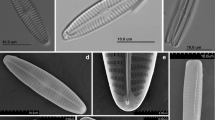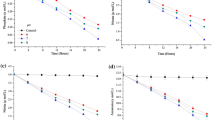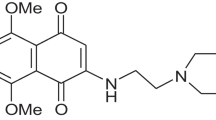Abstract
The availability of rapid and effective methodologies for assessing lotic systems with microphytobenthos is still quite scarce. Hence, the primary goal of this study was to optimize the growth conditions of the sensitive and ubiquous benthic diatom Navicula libonensis for laboratorial and field assessments. The effect of different conditions of temperature, photoperiod, initial cell density, test duration and cell encapsulation into calcium alginate beads was evaluated in a first set of experiments. There was a slight increase in the growth of free and immobilized cells at 23 °C, at lower initial cell densities and at the shortest experimental period (6 days). Through all the conditions, the growth profiles of free versus immobilized were fairly variable. A second experimental trial involved the validation of selected conditions, applied to the ecotoxicological testing of N. libonensis to two reference chemicals—3,5-dichlorophenol and potassium dichromate. A similar response of free and immobilized cells was observed between exposures to spiked stream water and synthetic medium, and through the conditions tested. This outcome suggests that N. libonensis may potentially provide reliable responses under direct in situ exposures.


Similar content being viewed by others
References
2000/60/EC (2000): Water Framework Directive of the European Parliament and the Council, of 23 October 2000, establishing a framework for community action in the field of water policy. Official Journal of the European Communities L 327, pp. 1–72
APHA (American Public Health Asssociation) (1995) Standard methods for the examination of water and wastewater, 19th edn. APHA, Washington DC
Araújo CV, Blasco J, Moreno-Garrido I (2010) Microphytobenthos in ecotoxicology: a review of the use of marine benthic diatoms in bioassays. Environ Int 36:637–646
Awasthi M, Rai LC (2005) Toxicity of nickel, zinc, and cadmium to nitrate uptake in free and immobilized cells of Scenedesmus quadricauda. Ecotoxicol Environ Saf 61:268–272
Bozeman J, Koopman B, Bitton G (1989) Toxicity testing using immobilized algae. Aquat Toxicol 14:345–352
Brabec K, Szoszkiewicz K (2006) Macrophytes and diatoms—major results and conclusions from the STAR project. Hydrobiologia 566:175–178
Cemagref (1982): Étude des mèthodes biologiques quantitatives d’appréciation de la qualit des eaux .Rapport Division Qualité des Eaux Lyon - Agence financière de Bassin Rhône - Méditerranée - Corse, Pierre-Bénite, 218 pp
Chu S (1942) The influence of the mineral composition of the medium on the growth of planktonic algae: part I. Methods and culture media. J Ecol 30:284–325
de Oliveira NS 2007: Caracterização físico-química e ecológica (diatomáceas) das linhas de água de Aveiro. M.Sc. thesis, University of Aveiro. 345pp
Environment Canada. 2007. Guidance document on statistical methods for environmental toxicity tests. Report EPS 1/RM/46, 241 p
Faafeng BA, van Donk E, Källqvist ST (1994) In situ measurement of algal growth potential in aquatic ecosystems by immobilized algae. J Appl Phycol 6:301–308
Feio MJ, Almeida SFP, Craveiro SC, Calado AJ (2009) A comparison between biotic indices and predictive models in stream water quality assessment based on benthic diatom communities. Ecol Indic 9:497–507
Gombotz WR, Wee S (1998) Protein release from alginate matrices. Adv Drug Deliv Rev 31:267–285
Hasle G (1978) The inverted-microscope method. In: Sournia A (ed) Phytoplankton manual. Monographs on oceanographic methodology. United Nations Educational, Scientific and Cultural Organzation (Unesco), Paris, pp 88–96
Hassan GS, Espinosa MA, Isla FI (2006) Modern diatom assemblages in surface sediments from estuarine systems in the Southeastern Buenos Aires Province, Argentina. J Paleolimnol 35:39–53
Hoogenhout H, Amesz J (1965) Growth rates of photosynthetic microorganisms in laboratory cultures. Arch Microbiol 50:10–25
INAG I. P. (2008): Tipologia de Rios em Portugal Continental no âmbito da implementação da Directiva Quadro da Água. I - Caracterização abiótica. Ministério do Ambiente, do Ordenamento do Território e do Desenvolvimento Regional. Instituto da Água, I.P.
ISO8692 (1989) Water quality—fresh water algal growth inhibition test with Scenedesmus subspicatus and Selenastrum capricornutum. International Organization for Standardization, Geneva
Jang LK (1994) Diffusivity of Cu2+ in calcium alginate gel beads. Biotechnol Bioeng 43:183–185
Jiménez-Pérez V, Sánchez-Castillo P, Romera O, Fernández-Moreno D, Pérez-Martínez C (2004) Growth and nutrient removal in free and immobilized planktonic green algae isolated from pig manure. Enzym Microb Technol 34:392–398
Khoyi ZA, Seyfabadi J, Ramezanpour Z (2009) Effects of light intensity and photoperiod on the growth rate, chlorophyll a and beta-carotene of freshwater green micro alga Chlorella vulgaris. Comp Biochem Physiol A Mol Integr Physiol 153A:S215–S215
Lam C, Harder T, Qian P-Y (2005) Growth conditions of benthic diatoms affect quality and quantity of extracellular polymeric larval settlement cues. Mar Ecol Prog Ser 294:109–116
Lewis RJ, Johnson LM, Hoagland KD (2002) Effects of cell density, temperature, and light intensity on growth and stalk production in the biofouling diatom Achnanthes longipes (Bacillariophyceae)1. J Phycol 38:1125–1131
Lorenzen C (1967) Determination of chlorophyll and pheo-pigments: spectrophotometric equations. Limnol Oceanogr 12:343–346
Mallick N (2002) Biotechnological potential of immobilized algae for wastewater N, P and metal removal: a review. BioMetals 15:377–390
Marques CR, Pereira R, Gonçalves F (2011) Toxicity evaluation of natural samples from the vicinity of rice fields using two trophic levels. Environ Monit Assess 180:521–536
Mayer P, Frickmann J, Christensen ER, Nyholm N (1998) Influence of growth conditions on the results obtained in algal toxicity tests. Environ Toxicol Chem 17:1091–1098
Moreira SM, Moreira-Santos M, Guilhermino L, Ribeiro R (2006) Immobilization of the marine microalga Phaeodactylum tricornutum in alginate for in situ experiments: bead stability and suitability. Enzym Microb Technol 38:135–141
Moreira-Santos M, Moreno-Garrido I, Gonçalves F, Soares A, Ribeiro R (2002) An in situ bioassay for estuarine environments using the microalga Phaeodactylum tricornutum. Environ Toxicol Chem 21:567–574
Moreira-Santos M, Soares A, Ribeiro R (2004a) A phytoplankton growth assay for routine in situ environmental assessments. Environ Toxicol Chem 23:1549–1560
Moreira-Santos M, Soares A, Ribeiro R (2004b) An in situ bioassay for freshwater environments with the microalga Pseudokirchneriella subcapitata. Ecotoxicol Environ Saf 59:164–173
Moreira-Santos M, da Silva E, Soares A, Ribeiro R (2005) In situ and laboratory microalgal assays in the tropics: a microcosm simulation of edge-of-field pesticide runoff. Bull Environ Contam Toxicol 74:48–55
Moreno-Garrido I (2008) Microalgae immobilization: current techniques and uses. Bioresour Technol 99:3949–3964
Moreno-Garrido I, Hampel M, Lubián L, Blasco J (2003) Sediment toxicity tests using benthic marine microalgae Cylindrotheca closterium (Ehremberg) Lewin and Reimann (Bacillariophyceae). Ecotoxicol Environ Saf 54:290–295
Moreno-Garrido I, Campana O, Lubián L, Blasco J (2005) Calcium alginate immobilized marine microalgae: experiments on growth and short-term heavy metal accumulation. Mar Pollut Bull 51:823–829
Moreno-Garrido I, Lubián L, Blasco J (2007) Sediment toxicity tests involving immobilized microalgae (Phaeodactylum tricornutum Bohlin). Environ Int 33:481–485
Newsted JL (2004) Effect of light, temperature, and pH on the accumulation of phenol by Selenastrum capricornutum, a green alga. Ecotoxicol Environ Saf 59:237–243
Novais MHCG 2011: Benthic diatoms in Portuguese watercourses. Ph.D. thesis, University of Évora, 224 pp
OECD (2011) Guidelines for testing chemicals in freshwater and cyanobacteria. Organization for Co-operation and Development, Paris
Pereira JL, Antunes SC, Castro BB, Marques CR, Gonçalves AMM, Gonçalves F, Pereira R (2009) Toxicity evaluation of three pesticides on non-target aquatic and soil organisms: commercial formulation versus active ingredient. Ecotoxicology 18:455–463
Poulíčková A, Hašler P, Lysáková M, Spears B (2008) The ecology of freshwater epipelic algae: an update. Phycologia 47:437–450
Qian H, Li J, Pan X, Jiang H, Sun L, Fu Z (2010) Photoperiod and temperature influence cadmium’s effects on photosynthesis-related gene transcription in Chlorella vulgaris. Ecotoxicol Environ Saf 73:1202–1206
Quinn G, Keough M (2002) Experimental design and data analysis for biologists. University Press, Cambridge
Rai L, Mallick N (1992) Removal and assessment of toxicity of Cu and Fe to Anabaena doliolum and Chlorella vulgaris using free and immobilized cells. World J Microbiol Biotechnol 8:110–114
Rimet F, Gomà J, Cambra J, Bertuzzi E, Cantonati M, Cappelletti C, Ciutti F, Cordonier A, Coste M, Delmas F (2007) Benthic diatoms in western European streams with altitudes above 800 M: characterisation of the main assemblages and correspondence with ecoregions. Diatom Res 22:147–188
Seeligmann C, Maidana NI, Morales M (2008) Diatomeas (Bacillariophyceae) de humedales de altura de la Provincia de Jujuy-Argentina. Bol Soc Argent Bot 43:1–17
SETAC (1993): Guidance document on sediment toxicity tests and bioassays for freshwater and marine environments. From the “workshop on Sediment Toxicity Assessment”, November, Renesse, The Netherlands
Silva M (2008) Evaluation and integrated monitoring of the water quality from the Cértima River. M.Sc. thesis, University of Aveiro, 119 pp
Sokal MA, Hall RI, Wolfe BB (2008) Relationships between hydrological and limnological conditions in lakes of the Slave River Delta (NWT, Canada) and quantification of their roles on sedimentary diatom assemblages. J Paleolimnol 39:533–550
Souffreau C, Vanormelingen P, Verleyen E, Sabbe K, Vyverman W (2010) Tolerance of benthic diatoms from temperate aquatic and terrestrial habitats to experimental desiccation and temperature stress. Phycologia 49:309–324
Spaulding S, Lubinski D, Potapova M (2010) Diatoms of the United States. http://westerndiatoms.colorado.edu Accessed on 14 May, 2013.
Twist H, Edwards AC, Codd GA (1997) A novel in-situ biomonitor using alginate immobilised algae (Scenedesmus subspicatus) for the assessment of eutrophication in flowing surface waters. Water Res 31:2066–2072
USEPA (2002) Short-term methods for estimating the chronic toxicity of effluents and receiving waters to freshwater organisms. U.S. Environmental Protection Agency EPA-821-R-02-013, Washington DC
Vidal T, Pereira J, Abrantes N, Almeida SP, Soares AVM, Gonçalves F (2014) Toxicity testing with the benthic diatom Navicula libonensis (Schoeman 1970): procedure optimisation and assessment of the species sensitivity to reference chemicals. Bull Environ Contam Toxicol 1–7
Wilson SE, Cumming BF, Smol JP (1994) Diatom-salinity relationships in 111 lakes from the Interior Plateau of British Columbia, Canada: the development of diatom-based models for paleosalinity reconstructions. J Paleolimnol 12:197–221
Wolfstein K, Stal LJ (2002) Production of extracellular polymeric substances (EPS) by benthic diatoms: effect of irradiance and temperature. Mar Ecol Prog Ser 236:13–22
Acknowledgments
Tânia Vidal, Catarina Marques, Joana Luísa Pereira and Nelson Abrantes received individual research grants from the Portuguese Foundation for Science and Technology (FCT) (SFRH/BD/48046/2008, SFRH/BPD/47292/2008, SFRH/BPD/44733/2008 and SFRH/BPD/84833/2012, respectively). This study was funded by national funds through FCT, and by the European Regional Development Fund (ERDF) through the Competitiveness Factors Operational Programme (COMPETE), under the scope of the projects PTDC/AAC-AMB/112438/2009 and PEst-C/MAR/LA0017/2013.
Conflict of interest
The authors declare that they have no conflict of interest.
Author information
Authors and Affiliations
Corresponding author
Additional information
Responsible editor: Philippe Garrigues
Rights and permissions
About this article
Cite this article
Vidal, T., Marques, C., Abrantes, N. et al. Optimization of growth conditions for laboratory and field assessments using immobilized benthic diatoms. Environ Sci Pollut Res 22, 5919–5930 (2015). https://doi.org/10.1007/s11356-014-3713-y
Received:
Accepted:
Published:
Issue Date:
DOI: https://doi.org/10.1007/s11356-014-3713-y




